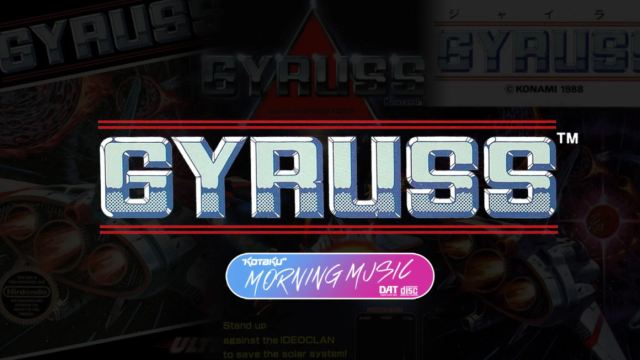Welcome to Morning Music, Kotaku’s new, daily hangout for folks who love video games and the cool-arse sounds they make. Today we’re checking out Gyruss, which impressed early arcade-goers with its switched-on Bach, then sounded even better on the NES and its Japan-only disk add-on.
1983’s Gyruss (longplay), by Time Pilot creator and future Street Fighter dad Yoshiki Okamoto, played like a combination of Galaga and Tempest: a space shooter in which your ship spun around the perimeter taking potshots at distant enemies swarming from the centre. Pretty solid hit.
One major attraction was its soundtrack, by Masahiro Inoue, which adapted J.S. Bach’s “Toccata and Fugue in D minor BWV 565” into boppy music to shoot by. Moreover, it may have been the first arcade game (any game?) with stereo sound — it’s very noticeable in the longplay! — though Guinness Records gives that honour to Atari Games’ 1984 Marble Madness, and I haven’t been able to figure out what hairs it’s splitting there. Maybe there’s some technical catch-22, or it’s scared of Mark Cerny.
Anyway, let’s listen:
Compare this to its 1983 contemporaries and you can hear why Gyruss turned heads. I really like that polyphonic fanfare it starts with. That said, these days it’s easy to notice the limitations of the main track; it sounds somewhat thin, hollow, lacking richness, almost like part of the song is missing at times.
Well, maybe the NES can improve on that. Here’s how Konami’s 1989 NES port (longplay) sounds:
Konami / GBelair (YouTube)
Oh yeah, much nicer. Love those high notes. Like many Konami NES games, it deploys the NES’ limited APU to great effect, adding more fullness and appealing new instrument choices to give a superior result. Moreover, the soundtrack is greatly expanded, adding excellent new tracks like this mini-boss theme (sounds straight out of Gradius in the best way), a splendid stage intro, and then the lovely (if quick to loop) bonus stage. And unlike the arcade game, it has an ending.
Well! That’s pretty cut and dried… until we note that there’s still a third version, as Konami released Gyruss for Nintendo’s Japan-only Famicom Disk System add-on in 1988 (longplay). And thanks to the FDS hardware’s extra wavetable audio channel, Gyruss sounded even better than it would on NES.
Compare and contrast:
Gonna declare a TKO. As good as the NES soundtrack is, the FDS’ is better. (There are some graphical and presentation differences too, such as a different title screen and a more elaborate ending sequence.)
Bonus corner? Bon — Wait, no, Gyruss has no corners. Bonus… round!
Gyruss has seen its share of covers over the years, and this metal-infused medley’s nicely done.
In 1980 the UK band Sky arranged Bach’s “Toccata and Fugue in D Minor” for “Toccata” in their album Sky 2, and it sounds very similar to Gyruss’ arrangement from just a few years later. Is Gyruss another case of early game composers liftin’ a little freely from inspiration?
Possibly. “Whomst amongst us can say,” as my friend is fond of asking. (The internet poisoned her.)
That’s it for today’s Morning Music! Feel free to spin into the comments — ”spin,” as if you were the ship from Gyruss, if that was unclear — and I’ll see y’all tomorrow.

Leave a Reply